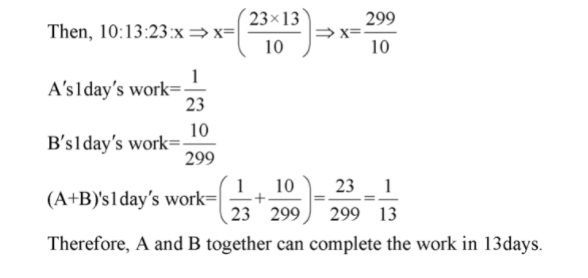A specific period of time (T) is required to finish a task (W). The rate of work is defined as the number of units completed per unit of time (R). As a result, Work (W) equals Rate (R) Time (T)
When some work is completed, the overall job might be considered as a single unit. As a result, in order to make computations easier, we treat all work done as a single unit in the situations we meet.
Efficiency Ratio – Work and Time
If A is three times as good as B at working, then:
The work ratio between A and B is 3:1.
The ratio of time it takes A and B to complete a task is 1: 3. This indicates that if someone claims A is ‘x’ times as excellent a worker as B, he will devote the same amount of time to B to do the same task.
Total work =No of days ×Efficiency
Problems based on Work and time
- A has a 30% efficiency advantage over B. How long will it take them to do a project that A might have completed in a period of 23 days if they worked together?

- A finishes a piece of work twice the time it takes B and three times the time it takes C. It will take them two days to accomplish the assignment if they all work together. How much work did B do on his own?

Cost Efficient:
The act of saving money by modifying a product or process to perform more efficiently is known as cost-efficiency. This is done in order to boost the organisation’s bottom line by lowering procurement costs and increasing overall efficiency.
While cost efficiency isn’t the be-all and end-all of business, it is a critical component of corporate strategy. The capacity to reduce costs and boost profits by streamlining procedures is critical to the value procurement brings to businesses.
The term “cost-effectiveness” refers to a set of indicators used to assess the outcomes of non-financial initiatives, programmes, projects, and activities
Calculation
The ratio of cost to benefit is used to determine cost-effectiveness.

Time Efficient
The capacity to organise and accomplish things in a timely and effective manner is known as time management. This involves determining how much time to devote to each job in order to maximise time during the day and week.
Many elements of job performance may be improved with better time management abilities. Employees are more productive and efficient, with the following outcomes:
Productivity increases
There will be less procrastinating.
More opportunities for advancement in your career
Improvements in decision-making and work-life balance
Employees are less stressed.
Time And Efficiency
The longer it takes someone to perform a task, the less efficient they are. Similarly, the faster someone completes a task, the more efficient they are. As a result, efficiency is inversely related to the time it takes to perform a task.
Conventional Method
It is assumed that two machines, each with different constant efficiency, fulfil a huge manufacturing order in four hours and three hours, respectively.
The work is constant here since the overall work done by both machines is the same.
Assume that the total work of the production order is one unit. As a result, we may say: • The first machine can do one unit of work in four hours.
- As a result, the first machine can do 1/4 units of work in an hour
- Similarly, the second machine can finish one unit of work in1/3 three hours
- If both machines operate at the same time, they can perform (1/4+1/3) units of work in an hour = (3+4)12(3+4)
12 units of work = 7/12 units of work • Because machines can perform 7/12 units of work in an hour, the entire work of 1 hour must be completed in that time.
How can you figure out how long it takes you to accomplish a job and how efficient you are?
Work Rate = 1 / Time Required Time taken = 1 / Work Rate If a piece of work takes x days to complete, the work completed in one day equals 1/x. Number of Days Efficiency = Total Wok Done
Example:
Samir takes about six days while Tanvir requires 8 days to finish a piece of work on his own. This work cost Samir and Tanvir Rs.2400. The task was completed three days after Amir joined them. What was Amir’s remuneration?

Conclusion
To complete a task, a particular amount of time (T) is necessary (W). The number of units done per unit of time is the rate of work (R). Work (W) = Rate (R) Time as a consequence (T)
When a portion of the task is accomplished, the entire project may be regarded as a single unit. As a consequence, in order to try and make computation easier, we regard all work completed in the scenarios we encounter as a single unit.
 Profile
Profile Settings
Settings Refer your friends
Refer your friends Sign out
Sign out






